Marine-Derived Collagen and Chitosan: Perspectives on Applications Using the Lens of UN SDGs and Blue Bioeconomy Strategies
Abstract
1. Introduction
2. An Overview of Marine-Derived Collagen and Chitin/Chitosan: Sources and Properties
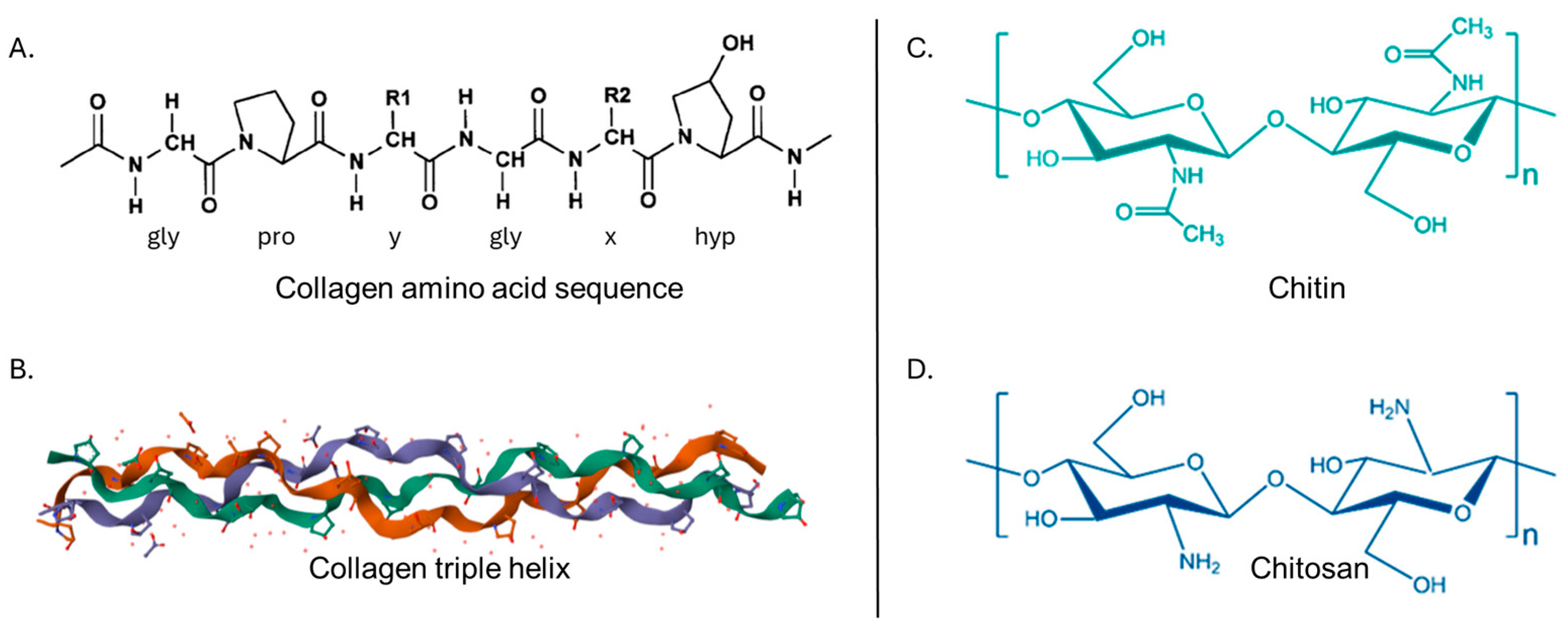
3. UN SDG Lens Applied to Marine-Derived Biopolymers
3.1. Marine-Derived Collagen and Chitin Sustainable Uses
3.1.1. Uses in Health, Agriculture, and Industry
3.1.2. Sustainability and Circular Economy
3.2. The EU Blue Bioeconomy and Challenges and Opportunities for Marine-Derived Biopolymers
4. Final Remarks
5. Materials and Methods
Author Contributions
Funding
Conflicts of Interest
References
- Rahman, A. Marine Collagen and Chitin: Promising Applications in Interdisciplinary Fields. Mar. Drugs 2024, 22, 379. [Google Scholar] [CrossRef]
- Flórez, M.; Guerra-Rodríguez, E.; Cazón, P.; Vázquez, M. Chitosan for Food Packaging: Recent Advances in Active and Intelligent Films. Food Hydrocoll. 2022, 124, 107328. [Google Scholar] [CrossRef]
- Piekarska, K.; Sikora, M.; Owczarek, M.; Jóźwik-Pruska, J.; Wiśniewska-Wrona, M. Chitin and Chitosan as Polymers of the Future—Obtaining, Modification, Life Cycle Assessment and Main Directions of Application. Polymers 2023, 15, 793. [Google Scholar] [CrossRef]
- Xu, N.; Peng, X.-L.; Li, H.-R.; Liu, J.-X.; Cheng, J.-S.-Y.; Qi, X.-Y.; Ye, S.-J.; Gong, H.-L.; Zhao, X.-H.; Yu, J.; et al. Marine-Derived Collagen as Biomaterials for Human Health. Front. Nutr. 2021, 8, 702108. [Google Scholar] [CrossRef]
- Carvalho, D.N.; Gonçalves, C.; Oliveira, J.M.; William, D.W.; Mearns-Spragg, A.; Reis, R.L.; Silva, T.H. Innovative Methodology for Marine Collagen–Chitosan–Fucoidan Hydrogels Production, Tailoring Rheological Properties towards Biomedical Application. Green. Chem. 2021, 23, 7016–7029. [Google Scholar] [CrossRef]
- Yano, S.; Yamaguchi, K.; Shibata, M.; Ifuku, S.; Teramoto, N. Photocrosslinked Fish Collagen Peptide/Chitin Nanofiber Composite Hydrogels from Marine Resources: Preparation, Mechanical Properties, and an In Vitro Study. Polymers 2023, 15, 682. [Google Scholar] [CrossRef]
- Singh, S. Chitin, Chitosan, and Derivatives Market Research Report: Information by Type (Chitin, Chitosan, Glucosamine, and Others), Application (Food & Beverages, Pharmaceuticals Nutraceuticals, Animal Feed, Agriculture, and Others), And by Region (North America, Europe, Asia-Pacific, And Rest Of The World) –Market Forecast Till 2032. In Chitin Chitosan Derivatives Market; Market Research Future: New York, NY, USA, 2019. [Google Scholar]
- Gotadki, R. Marine Collagen Market Research Report By Source, By Form, By Application, By Target Consumers, By Distribution Channel, By Regional Source. In Marine Collagen Market; Market Research Future: New York, NY, USA, 2024. [Google Scholar]
- Martínez-Puig, D.; Costa-Larrión, E.; Rubio-Rodríguez, N.; Gálvez-Martín, P. Collagen Supplementation for Joint Health: The Link between Composition and Scientific Knowledge. Nutrients 2023, 15, 1332. [Google Scholar] [CrossRef]
- Shahrajabian, M.H.; Chaski, C.; Polyzos, N.; Tzortzakis, N.; Petropoulos, S.A. Sustainable Agriculture Systems in Vegetable Production Using Chitin and Chitosan as Plant Biostimulants. Biomolecules 2021, 11, 819. [Google Scholar] [CrossRef] [PubMed]
- Vieira, H.; Leal, M.C.; Calado, R. Fifty Shades of Blue: How Blue Biotechnology Is Shaping the Bioeconomy. Trends Biotechnol. 2020, 38, 940–943. [Google Scholar] [CrossRef] [PubMed]
- Pakseresht, A.; Kermani, A.; Decker-Lange, C. Towards a Sustainable and Circular Blue Bioeconomy: A Scoping Review. Technol. Forecast. Soc. Change 2025, 216, 124157. [Google Scholar] [CrossRef]
- Dondero, L.; De Negri Atanasio, G.; Tardanico, F.; Lertora, E.; Boggia, R.; Capra, V.; Cometto, A.; Costamagna, M.; LSE, F.; Feletti, M.; et al. Unlocking the Potential of Marine Sidestreams in the Blue Economy: Lessons Learned from the EcoeFISHent Project on Fish Collagen. Mar. Biotechnol. 2025, 27, 63. [Google Scholar] [CrossRef]
- Zilia, F.; Orsi, L.; Costantini, M.; Tedesco, D.E.A.; Sugni, M. Case Study of Life Cycle Assessment and Sustainable Business Model for Sea Urchin Waste. Clean. Environ. Syst. 2023, 8, 100108. [Google Scholar] [CrossRef]
- Lees, L.; Paupério, M.; Rätsep, M.; Gasiūnaitė, Z.R.; Vaitkevičienė, V.; Tosatto, S.; Terenzi, A.; Andrén, S.; Aps, R.; Orav-Kotta, H.; et al. Crafting Blue Visions for a Sustainable Blue Bioeconomy in European Coastal Regions through Communities of Practice. Ocean. Coast. Manag. 2025, 262, 107588. [Google Scholar] [CrossRef]
- Barañano, L.; Garbisu, N.; Alkorta, I.; Araujo, A.; Garbisu, C. Contextualization of the Bioeconomy Concept through Its Links with Related Concepts and the Challenges Facing Humanity. Sustainability 2021, 13, 7746. [Google Scholar] [CrossRef]
- Vieira, H.; Almeida, M.; Shafique, M.N.; Leal, M.C.; Lillebø, A.I. Policy Impacts of Intellectual Property and Academic Research Trends in Marine-Derived Collagen and Chitin/Chitosan Value Chains. Mar. Policy 2025, 173, 106575. [Google Scholar] [CrossRef]
- Shoulders, M.D.; Raines, R.T. Collagen Structure and Stability. Annu. Rev. Biochem. 2009, 78, 929–958. [Google Scholar] [CrossRef] [PubMed]
- Silva, T.H.; Moreira-Silva, J.; Marques, A.L.P.; Domingues, A.; Bayon, Y.; Reis, R.L. Marine Origin Collagens and Its Potential Applications. Mar. Drugs 2014, 12, 5881–5901. [Google Scholar] [CrossRef] [PubMed]
- de Melo Oliveira, V.; Assis, C.R.D.; de Aquino Marques Costa, B.; de Araújo Neri, R.C.; Monte, F.T.D.; da Costa Vasconcelos Freitas, H.M.S.; França, R.C.P.; Santos, J.F.; de Souza Bezerra, R.; Porto, A.L.F. Physical, Biochemical, Densitometric and Spectroscopic Techniques for Characterization Collagen from Alternative Sources: A Review Based on the Sustainable Valorization of Aquatic by-Products. J. Mol. Struct. 2021, 1224, 129023. [Google Scholar] [CrossRef]
- Almeida, M.; Silva, T.; Solstad, R.G.; Lillebø, A.I.; Calado, R.; Vieira, H. How Significant Are Marine Invertebrate Collagens? Exploring Trends in Research and Innovation. Mar. Drugs 2024, 23, 2. [Google Scholar] [CrossRef]
- Islam, J.; Mis Solval, K.E. Recent Advancements in Marine Collagen: Exploring New Sources, Processing Approaches, and Nutritional Applications. Mar. Drugs 2025, 23, 190. [Google Scholar] [CrossRef]
- Zhang, S.; Ji, Y.; He, Y.; Dong, J.; Li, H.; Yu, S. Effect of Environmental PH on the Mechanics of Chitin and Chitosan: A Single-Molecule Study. Polymers 2024, 16, 995. [Google Scholar] [CrossRef] [PubMed]
- Aranaz, I.; Alcántara, A.R.; Civera, M.C.; Arias, C.; Elorza, B.; Heras Caballero, A.; Acosta, N. Chitosan: An Overview of Its Properties and Applications. Polymers 2021, 13, 3256. [Google Scholar] [CrossRef]
- Kurita, K. Chitin and Chitosan: Functional Biopolymers from Marine Crustaceans. Mar. Biotechnol. 2006, 8, 203–226. [Google Scholar] [CrossRef]
- Vieira, H.; Lestre, G.M.; Solstad, R.G.; Cabral, A.E.; Botelho, A.; Helbig, C.; Coppola, D.; de Pascale, D.; Robbens, J.; Raes, K.; et al. Current and Expected Trends for the Marine Chitin/Chitosan and Collagen Value Chains. Mar. Drugs 2023, 21, 605. [Google Scholar] [CrossRef]
- Frenchibai, P.B.B.; Vinayagam, R.; Ambigapathi, D.; Anbazhagan, G.K.; Elumalai, L.; Palaniyandi, S.; Siddan, N.; Thangam, G.S.; Dharmalingam, K. Chitosan from Shells of Crustaceans and Its Application in the Synthesis of Biodegradable Polymers. Biomed. Mater. Devices 2025, 1–10. [Google Scholar] [CrossRef]
- Hamdi, M.; Wang, D.; Li, S.; Su, F. Unveiling an Innovative Sustainable Blue Resource-Ecofriendly Extraction Technique towards a Circular Economy: Optimization of Natural Deep Eutectic Solvent and Ultrasonication Synergistic Pathways for Type-I Collagen Refined Recovery from Discarded Fish Scales. Int. J. Biol. Macromol. 2025, 300, 140296. [Google Scholar] [CrossRef]
- Laasri, I.; Bakkali, M.; Mejias, L.; Laglaoui, A. Marine Collagen: Unveiling the Blue Resource-Extraction Techniques and Multifaceted Applications. Int. J. Biol. Macromol. 2023, 253, 127253. [Google Scholar] [CrossRef]
- Zhu, H.; Chen, S.; Xue, J.; Wang, R.; Wang, X.; Xiao, Z.; Luo, Y. Chitin Nanofibers Derived from Deep Eutectic Solvent Extraction and Ammonium Persulfate Oxidation as a Seed Nanopriming Agent for Microgreen Growth Enhancement. Sustain. Food Technol. 2025, 3, 677–688. [Google Scholar] [CrossRef]
- Gutierrez-Canul, C.D.; Can-Herrera, L.A.; de Jesús Ramírez-Rivera, E.; Prinyawiwatkul, W.; Sauri-Duch, E.; Moo-Huchin, V.M.; Hernández-Núñez, E. A Review of Classical and Rising Approaches the Extraction and Utilization of Marine Collagen. BioTech 2025, 14, 26. [Google Scholar] [CrossRef] [PubMed]
- Mohan, K.; Ganesan, A.R.; Ezhilarasi, P.N.; Kondamareddy, K.K.; Rajan, D.K.; Sathishkumar, P.; Rajarajeswaran, J.; Conterno, L. Green and Eco-Friendly Approaches for the Extraction of Chitin and Chitosan: A Review. Carbohydr. Polym. 2022, 287, 119349. [Google Scholar] [CrossRef] [PubMed]
- Diogo, G.S.; López-Senra, E.; Pirraco, R.P.; Canadas, R.F.; Fernandes, E.M.; Serra, J.; Pérez-Martín, R.I.; Sotelo, C.G.; Marques, A.P.; González, P.; et al. Marine Collagen/Apatite Composite Scaffolds Envisaging Hard Tissue Applications. Mar. Drugs 2018, 16, 269. [Google Scholar] [CrossRef]
- Ferrario, C.; Rusconi, F.; Pulaj, A.; Macchi, R.; Landini, P.; Paroni, M.; Colombo, G.; Martinello, T.; Melotti, L.; Gomiero, C.; et al. From Food Waste to Innovative Biomaterial: Sea Urchin-Derived Collagen for Applications in Skin Regenerative Medicine. Mar. Drugs 2020, 18, 414. [Google Scholar] [CrossRef] [PubMed]
- León-López, A.; Morales-Peñaloza, A.; Martínez-Juárez, V.M.; Vargas-Torres, A.; Zeugolis, D.I.; Aguirre-Álvarez, G. Hydrolyzed Collagen—Sources and Applications. Molecules 2019, 24, 4031. [Google Scholar] [CrossRef]
- Aguirre-Cruz, G.; León-López, A.; Cruz-Gómez, V.; Jiménez-Alvarado, R.; Aguirre-Álvarez, G. Collagen Hydrolysates for Skin Protection: Oral Administration and Topical Formulation. Antioxidants 2020, 9, 181. [Google Scholar] [CrossRef] [PubMed]
- Li, P.H.; Lu, W.C.; Chan, Y.J.; Ko, W.C.; Jung, C.C.; Le Huynh, D.T.; Ji, Y.X. Extraction and Characterization of Collagen from Sea Cucumber (Holothuria Cinerascens) and Its Potential Application in Moisturizing Cosmetics. Aquaculture 2020, 515, 734590. [Google Scholar] [CrossRef]
- Tunku Mahmud, T.H.; Abdul-Aziz, A.; Muda, R. A Review on the Potential Use of Chitosan-Based Delivery System in Mild Facial Cleansing Formulation. Int. J. Polym. Mater. Polym. Biomater. 2015, 64, 432–437. [Google Scholar] [CrossRef]
- Guzmán, E.; Ortega, F.; Rubio, R.G. Chitosan: A Promising Multifunctional Cosmetic Ingredient for Skin and Hair Care. Cosmetics 2022, 9, 99. [Google Scholar] [CrossRef]
- Hamed, I.; Özogul, F.; Regenstein, J.M. Industrial Applications of Crustacean By-Products (Chitin, Chitosan, and Chitooligosaccharides): A Review. Trends Food Sci. Technol. 2016, 48, 40–50. [Google Scholar] [CrossRef]
- Baharlouei, P.; Rahman, A. Chitin and Chitosan: Prospective Biomedical Applications in Drug Delivery, Cancer Treatment, and Wound Healing. Mar. Drugs 2022, 20, 460. [Google Scholar] [CrossRef]
- Bertrand, M.; Simonin, S.; Bach, B. Applications of Chitosan in the Agri-Food Sector: A Review. Carbohydr. Res. 2024, 543, 109219. [Google Scholar] [CrossRef]
- Ronnasi, B.; McKillop, S.P.; Ourabi, M.; Perry, M.; Sharp, H.A.; Lessard, B.H. Chitosan-Based Electronics: The Importance of Acid Strength and Plasticizing Additives on Device Performance. ACS Appl. Mater. Interfaces 2024, 16, 65425–65435. [Google Scholar] [CrossRef] [PubMed]
- United Nations. Transforming Our World: The 2030 Agenda for Sustainable Development. In Proceedings of the Resolution Adopted by the General Assembly, New York, NY, USA, 25 September 2015; pp. 1–13, 42809. [Google Scholar]
- United Nations. The Sustainable Development Goals Report 2024. 2024. Available online: https://unstats.un.org/sdgs/report/2024/ (accessed on 25 July 2025).
- Shaik, M.I.; Rahman, S.H.A.; Yusri, A.S.; Ismail-Fitry, M.R.; Kumar, N.S.S.; Sarbon, N.M. A Review on the Processing Technique, Physicochemical, and Bioactive Properties of Marine Collagen. J. Food Sci. 2024, 89, 5205–5229. [Google Scholar] [CrossRef]
- Satitsri, S.; Muanprasat, C. Chitin and Chitosan Derivatives as Biomaterial Resources for Biological and Biomedical Applications. Molecules 2020, 25, 5961. [Google Scholar] [CrossRef] [PubMed]
- Younes, I.; Rinaudo, M. Chitin and Chitosan Preparation from Marine Sources. Structure, Properties and Applications. Mar. Drugs 2015, 13, 1133–1174. [Google Scholar] [CrossRef] [PubMed]
- Cadar, E.; Pesterau, A.-M.; Sirbu, R.; Negreanu-Pirjol, B.S.; Tomescu, C.L. Jellyfishes—Significant Marine Resources with Potential in the Wound-Healing Process: A Review. Mar. Drugs 2023, 21, 201. [Google Scholar] [CrossRef]
- Chen, J.-K.; Yeh, C.-H.; Wang, L.-C.; Liou, T.-H.; Shen, C.-R.; Liu, C.-L. Chitosan, the Marine Functional Food, Is a Potent Adsorbent of Humic Acid. Mar. Drugs 2011, 9, 2488–2498. [Google Scholar] [CrossRef]
- In Jeong, S.; Kim, S.Y.; Cho, S.K.; Chong, M.S.; Kim, K.S.; Kim, H.; Lee, S.B.; Lee, Y.M. Tissue-Engineered Vascular Grafts Composed of Marine Collagen and PLGA Fibers Using Pulsatile Perfusion Bioreactors. Biomaterials 2007, 28, 1115–1122. [Google Scholar] [CrossRef]
- Jin-feng, D.; Xiu-Rong, S.; Yan-yan, L.; Xiang, G.; Fu-peng, Y.; Xin, J. The Hypolipidemic and Antioxidative Effects of Jellyfish Collagen Peptide. Nat. Product. Res. Dev. 2012, 24, 362–365. [Google Scholar]
- Wong, R.P.M.; Zhou, Z.K.; Strappe, P.M. The Anti-Obesogenic and Anti-Diabetic Properties of Marine Collagen Peptides. Front. Food Sci. Technol. 2024, 3, 1270392. [Google Scholar] [CrossRef]
- Singh, B.; Maharjan, S.; Cho, K.-H.; Cui, L.; Park, I.-K.; Choi, Y.-J.; Cho, C.-S. Chitosan-Based Particulate Systems for the Delivery of Mucosal Vaccines against Infectious Diseases. Int. J. Biol. Macromol. 2018, 110, 54–64. [Google Scholar] [CrossRef]
- Román-Doval, R.; Torres-Arellanes, S.P.; Tenorio-Barajas, A.Y.; Gómez-Sánchez, A.; Valencia-Lazcano, A.A. Chitosan: Properties and Its Application in Agriculture in Context of Molecular Weight. Polymers 2023, 15, 2867. [Google Scholar] [CrossRef]
- Abdulhameed, A.S.; Abdullah, S.; Al-Masud, A.A.; Al Omari, R.H.; Abualhaija, M.; Algburi, S. Production of Sustainable Adsorbent of Crosslinked Chitosan-Oxalate and Modified Mango (Mangifera indica L.) Seed for Highly Efficient Adsorption of Crystal Violet Dye: Water Treatment and Biomass Valorization. Biomass Bioenergy 2025, 199, 107889. [Google Scholar] [CrossRef]
- Govindharaj, M.; Roopavath, U.K.; Rath, S.N. Valorization of Discarded Marine Eel Fish Skin for Collagen Extraction as a 3D Printable Blue Biomaterial for Tissue Engineering. J. Clean. Prod. 2019, 230, 412–419. [Google Scholar] [CrossRef]
- Liu, Z.; Xue, Y.; Yang, J.; Lin, W.; Babichuk, I.S. Sustainable, Biodegradable, Flexible Piezoelectric Quaternary Ammonium Chitosan Film Pressure Sensors for Human Motion Detection and Human-Computer Interaction. Sens. Actuators A Phys. 2025, 389, 116549. [Google Scholar] [CrossRef]
- Rahman, M.M.; Maniruzzaman, M. A New Route of Production of the Meso-Porous Chitosan with Well-Organized Honeycomb Surface Microstructure from Shrimp Waste without Destroying the Original Structure of Native Shells: Extraction, Modification and Characterization Study. Results Eng. 2023, 19, 101362. [Google Scholar] [CrossRef]
- El Feky, A.R.; Ismaiel, M.; Yılmaz, M.; Madkour, F.M.; El Nemr, A.; Ibrahim, H.A.H. Biodegradable Plastic Formulated from Chitosan of Aristeus Antennatus Shells with Castor Oil as a Plasticizer Agent and Starch as a Filling Substrate. Sci. Rep. 2024, 14, 11161. [Google Scholar] [CrossRef]
- da Paixão Cansado, I.P.; Mourão, P.A.M.; Castanheiro, J.E.; Geraldo, P.F.; Suhas; Suero, S.R.; Cano, B.L. A Review of the Biomass Valorization Hierarchy. Sustainability 2025, 17, 335. [Google Scholar] [CrossRef]
- Fraga-Corral, M.; Ronza, P.; Garcia-Oliveira, P.; Pereira, A.G.; Losada, A.P.; Prieto, M.A.; Quiroga, M.I.; Simal-Gandara, J. Aquaculture as a Circular Bio-Economy Model with Galicia as a Study Case: How to Transform Waste into Revalorized by-Products. Trends Food Sci. Technol. 2022, 119, 23–35. [Google Scholar] [CrossRef]
- Almeida, M.; Corticeiro, S.; Oliveira, B.R.F.; Laranjeiro, D.; Lillebø, A.; Vieira, H. The Needs and Challenges of the Blue Economy Sector in Portugal: Bridging National and European Strategies with the Perceptions of the Stakeholders. J. Environ. Manag. 2025, 384, 125468. [Google Scholar] [CrossRef]
- Challenge 4:Develop a Sustainable and Equitable Ocean Economy. In UNESCO-IOC Ocean DecadeVision 2030 White Papers; UNESCO-IOC: Paris, France, 2024; (The Ocean Decade Series, 51.4.).
- Rahaman, S.; Dana, L.P.; Anjum, N. Empowering Women in Building a Sustainable Blue Economy. In Handbook of Sustainable Blue Economy; Springer Nature Switzerland: Cham, Switzerland, 2024; pp. 1–20. [Google Scholar]
- European Comission. The European Ocean Pact. In Proceedings of the Communication from the Commission to the European Parliament, the Council, the European Economic and Social Committee and the Committee of the Regions, Brussels, Belgium, 5 June 2025. [Google Scholar]
- CBE JU Circular Bio-Based Europe Joint Undertaking CBE JU Recommendations; Brussels. 2024. Available online: https://icus-society.org/wp-content/uploads/2024/09/ESCCCS-2024-guideline7.pdf (accessed on 30 June 2025).
- Amiri, H.; Aghbashlo, M.; Sharma, M.; Gaffey, J.; Manning, L.; Moosavi Basri, S.M.; Kennedy, J.F.; Gupta, V.K.; Tabatabaei, M. Chitin and Chitosan Derived from Crustacean Waste Valorization Streams Can Support Food Systems and the UN Sustainable Development Goals. Nat. Food 2022, 3, 822–828. [Google Scholar] [CrossRef] [PubMed]
- FAO Global Production by Production Source Quantity (1950–2022). 2022. Available online: https://www.fao.org/fishery/statistics-query/en/global_production/global_production_quantity (accessed on 1 May 2025).
- Carvalho, D.N.; Gonçalves, C.; Sousa, R.O.; Reis, R.L.; Oliveira, J.M.; Silva, T.H. Extraction and Purification of Biopolymers from Marine Origin Sources Envisaging Their Use for Biotechnological Applications. Mar. Biotechnol. 2024, 26, 1079–1119. [Google Scholar] [CrossRef]
- Srinivasan, A.; Gupta, A.; Narayanamurthy, V. A Comprehensive Review of AI-Based Collagen Valorization: Recent Trends, Innovations in Extraction, and Applications. Green. Anal. Chem. 2025, 12, 100212. [Google Scholar] [CrossRef]
- Augusto, A.; Lemos, M.; Silva, S. Exploring Marine-Based Food Production: The Challenges for a Sustainable and Fast Biotechnology-Based Development. Appl. Sci. 2024, 14, 8255. [Google Scholar] [CrossRef]
- Kantak, M.N.; Bharate, S.S. Analysis of Clinical Trials on Biomaterial and Therapeutic Applications of Chitosan: A Review. Carbohydr. Polym. 2022, 278, 118999. [Google Scholar] [CrossRef]
- Rotter, A.; Giannakourou, A.; Argente García, J.E.; Quero, G.M.; Auregan, C.; Triantaphyllidis, G.; Venetsanopoulou, A.; De Carolis, R.; Efstratiou, C.; Aboal, M.; et al. Identification of Marine Biotechnology Value Chains with High Potential in the Northern Mediterranean Region. Mar. Drugs 2023, 21, 416. [Google Scholar] [CrossRef]
- Faulkner, J.P.; Murphy, E.; Scott, M. Downscaling EU Bioeconomy Policy for National Implementation. Clean. Circ. Bioecon. 2024, 9, 100121. [Google Scholar] [CrossRef]
- KeriMedical REAXON® DIRECT–REPAIR OF PERIPHERAL NERVE DISCONTINUITIES. Available online: https://www.kerimedical.com/en/portail-kerimedical-en/home-professional/reaxon-direct/ (accessed on 25 July 2025).
- Primex ChitoClear. Available online: https://www.primex.is/ (accessed on 25 July 2025).
- Caruso, G.; Floris, R.; Serangeli, C.; Di Paola, L. Fishery Wastes as a Yet Undiscovered Treasure from the Sea: Biomolecules Sources, Extraction Methods and Valorization. Mar. Drugs 2020, 18, 622. [Google Scholar] [CrossRef]
- Kerecis. FISH SKIN GRAFTS RICH IN OMEGA-3 FATTY ACIDS. Available online: https://www.kerecis.com/omega3-wound/ (accessed on 25 July 2025).
- Rotter, A.; Varamogianni-Mamatsi, D.; Zvonar Pobirk, A.; Gosenca Matjaž, M.; Cueto, M.; Díaz-Marrero, A.R.; Jónsdóttir, R.; Sveinsdóttir, K.; Catalá, T.S.; Romano, G.; et al. Marine Cosmetics and the Blue Bioeconomy: From Sourcing to Success Stories. iScience 2024, 27, 111339. [Google Scholar] [CrossRef]
- Olunusi, S.O.; Ramli, N.H.; Adam, F.; Hossain, E.; Kim, T.H. Chitosan as a Sustainable Alternative for Fresh Food Packaging: Structural Insights, Modification Strategies, and Innovations for Commercial Viability. Int. J. Biol. Macromol. 2025, 318, 145065. [Google Scholar] [CrossRef] [PubMed]
- Hu, B.; Zong, Z.; Han, L.; Cao, J.; Yang, J.; Zheng, Q.; Zhang, X.; Liu, Y.; Yao, Z. Jellyfish Collagen: A Promising and Sustainable Marine Biomaterial with Emerging Applications in Food, Cosmetics, and Biomedical—A Review. Appl. Food Res. 2025, 5, 101165. [Google Scholar] [CrossRef]
- Eurostat Sustainable Development in the European Union Monitoring Report on Progress towards the SDGs in an EU Context; Publications Office of the European Union: Luxembourg, 2024.
- Thompson, F.; Krüger, R.; Thompson, C.C.; Berlinck, R.G.S.; Coutinho, R.; Landell, M.F.; Pavão, M.; Mourão, P.A.S.; Salles, A.; Negri, N.; et al. Marine Biotechnology in Brazil: Recent Developments and Its Potential for Innovation. Front. Mar. Sci. 2018, 5, 236. [Google Scholar] [CrossRef]
- Rudovica, V.; Rotter, A.; Gaudêncio, S.P.; Novoveská, L.; Akgül, F.; Akslen-Hoel, L.K.; Alexandrino, D.A.M.; Anne, O.; Arbidans, L.; Atanassova, M.; et al. Valorization of Marine Waste: Use of Industrial By-Products and Beach Wrack Towards the Production of High Added-Value Products. Front. Mar. Sci. 2021, 8, 723333. [Google Scholar] [CrossRef]
- European Union. The EU Blue Economy Report—2025 Edition; Publications Office of the European Union: Luxembourg, 2025. [Google Scholar]
- Sachs, J.D.; Lafortune, G.; Fuller, G. SUSTAINABLE DEVELOPMENT REPORT 2025 Financing Sustainable Development to 2030 and Mid-Century; Dublin University Press: Dublin, Ireland, 2025. [Google Scholar]
- OECD. Promoting Sustainable Ocean Economies. In Best Practices in Development Co-operation; OECD Publishing: Paris, France, 2025. [Google Scholar] [CrossRef]
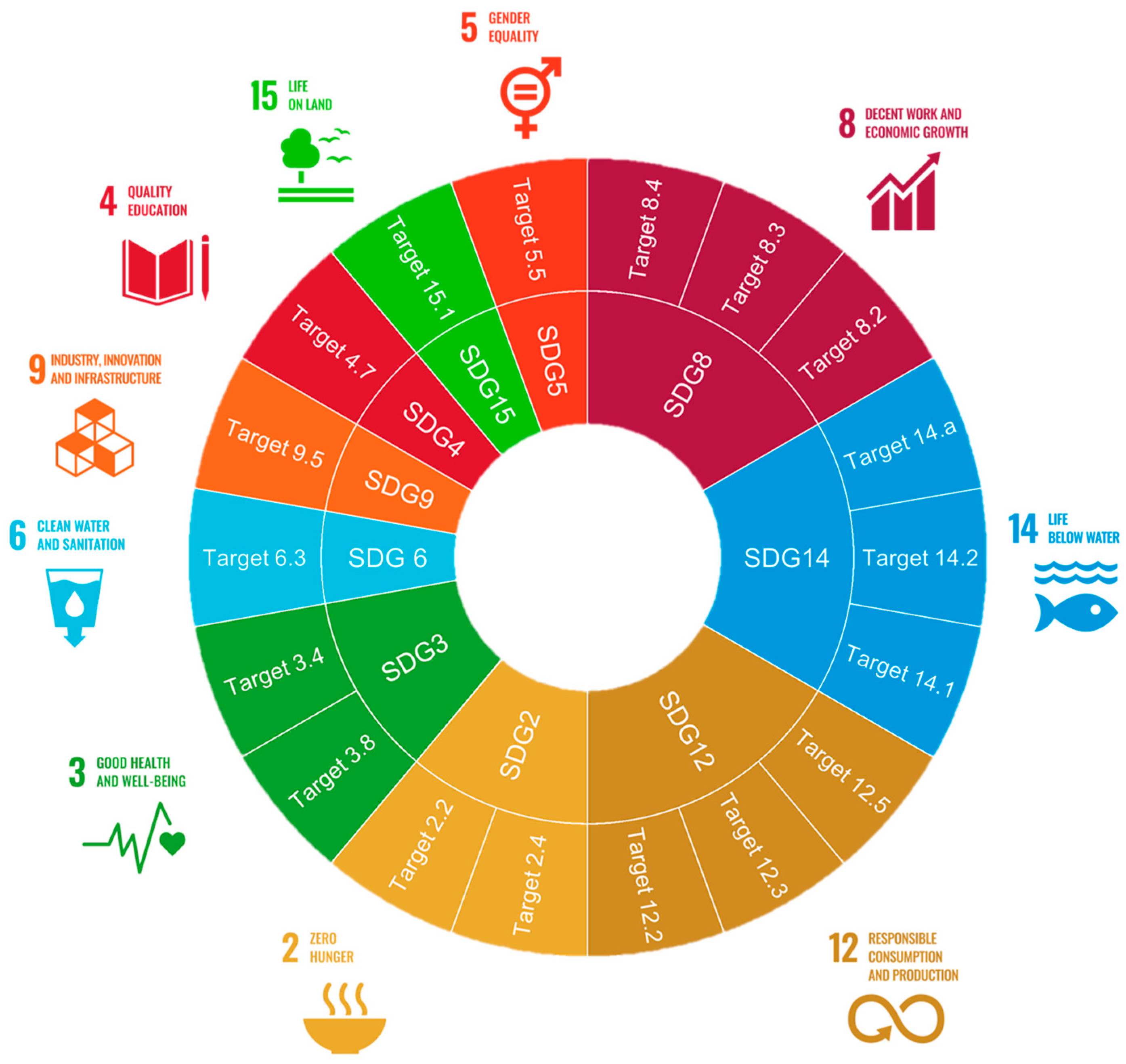
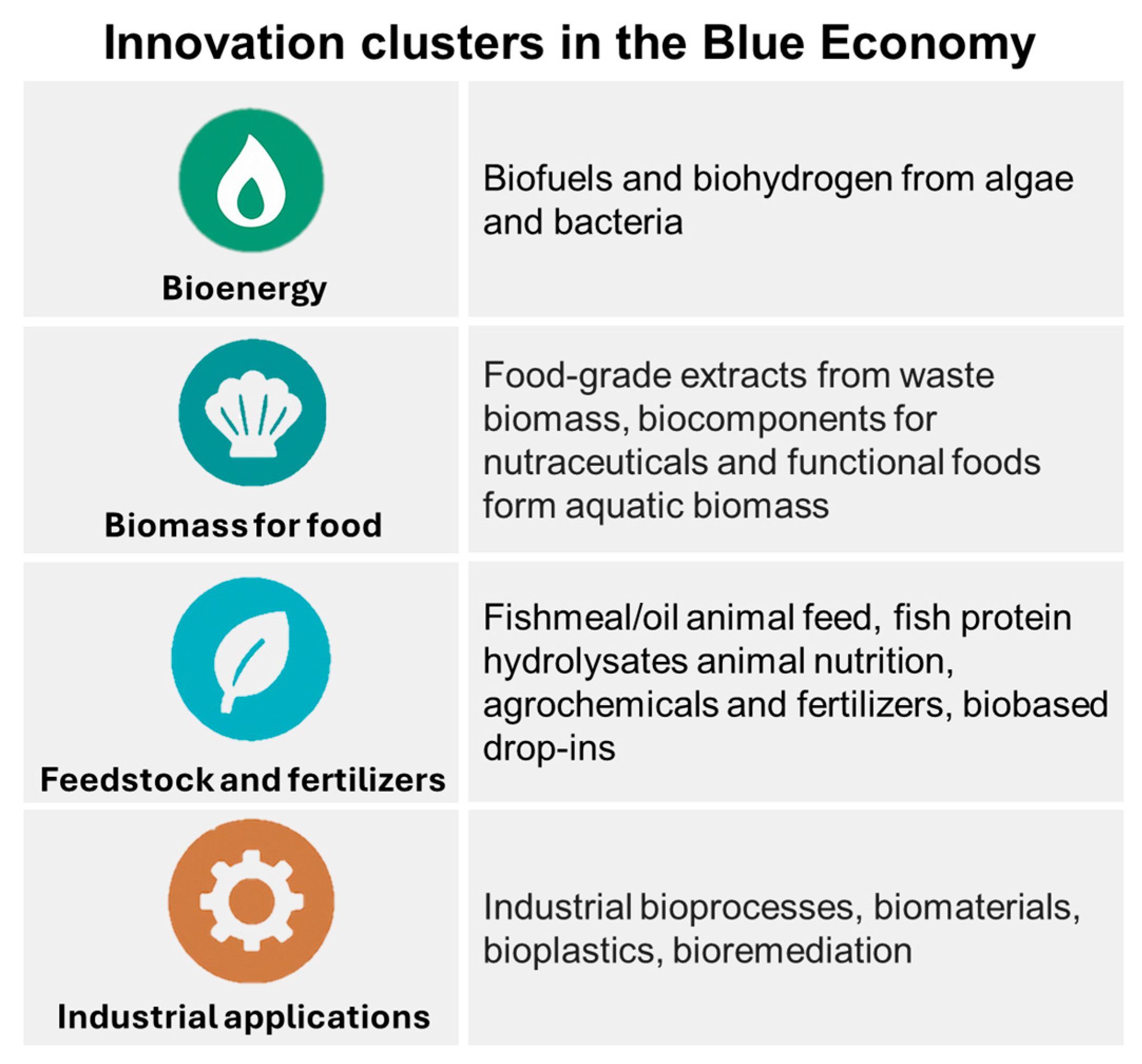
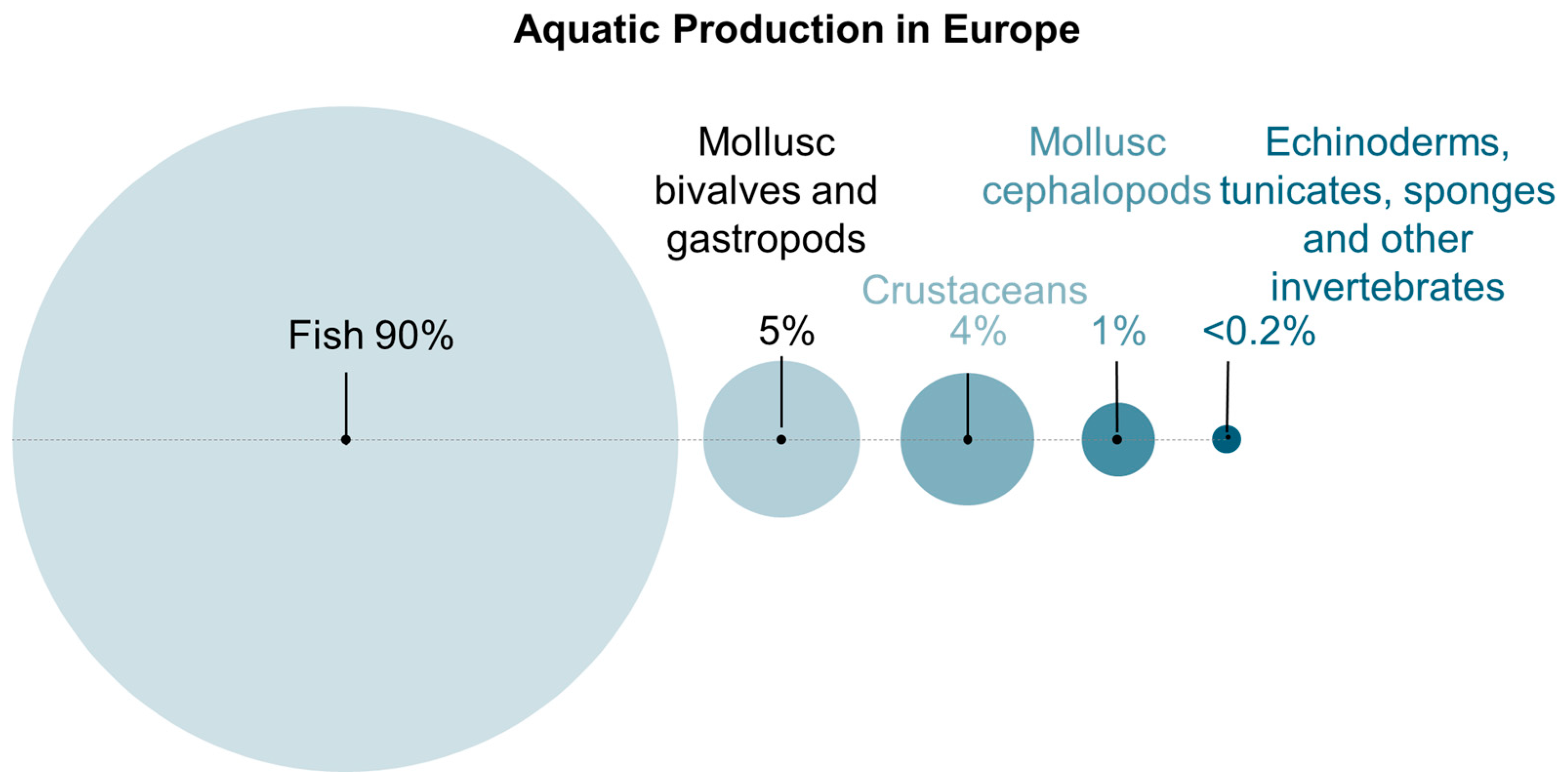
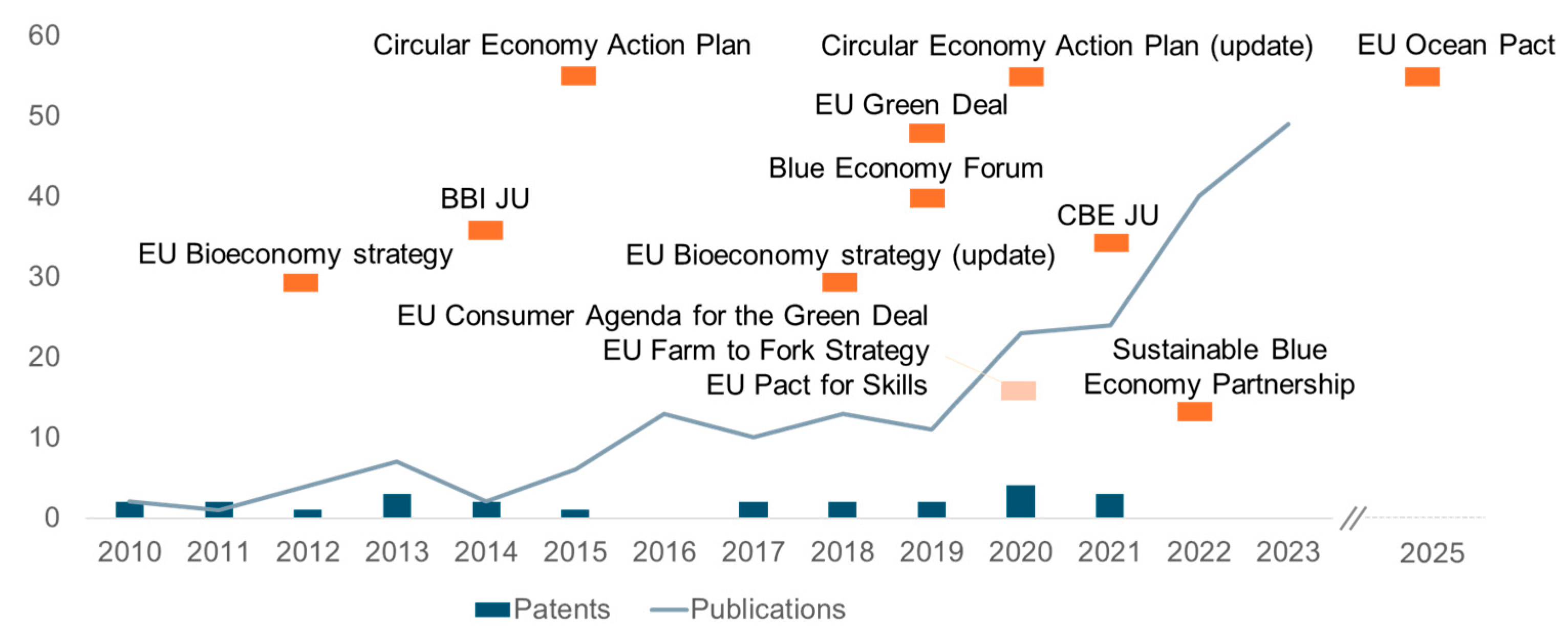
| Marine Collagen | Marine Chitosan (from Chitin) | |
|---|---|---|
Chemical Structure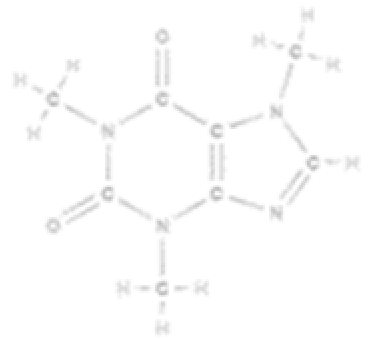 |
|
|
Sustainable Sources |
|
|
Sustainable Processing/Extraction |
|
|
Properties |
|
|
| Key Biomedical/Pharmaceutical Applications  |
|
|
Cosmetic Applications |
|
|
Food/Nutraceutical Uses |
|
|
Environmental Uses | Limited (potential in sustainability but underexplored commercially) |
|
| Commercial Trend & Patents  |
|
|
| Area | Applicable SDGs | Applicable Targets | Progress | Collagen | Chitin |
|---|---|---|---|---|---|
| Potential Contribution | |||||
| Section 1—Application-Driven SDG Contributions | |||||
Healthcare | 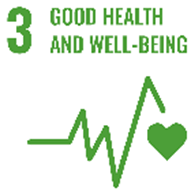 | 3.4 reduce premature mortality from non-communicable diseases | 🟨 | 🟢 | 🟢 |
| 3.8 access to safe, quality, affordable medicines and vaccines | 🟥 | 🟢 | 🟢 | ||
Cosmetics | 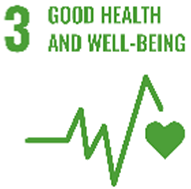 | 3.9 reduce health impact from hazardous chemicals and air, water, and soil pollution and contamination | 🟩 | 🔴 | 🔴 |
Food & Nutrition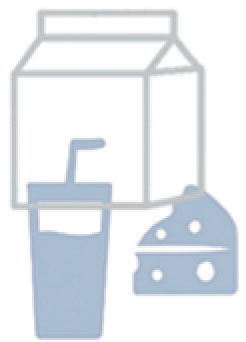 |  | 2.2 address nutritional needs | 🟥 | 🟢 | 🟡 |
Water treatment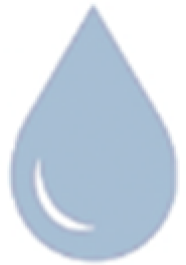 | 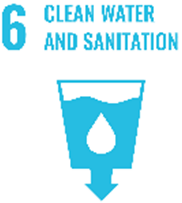 | 6.3 improve water quality by reducing pollution | 🟨 | 🔴 | 🟡 |
Agriculture 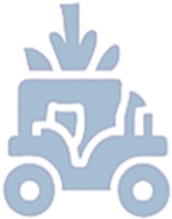 | 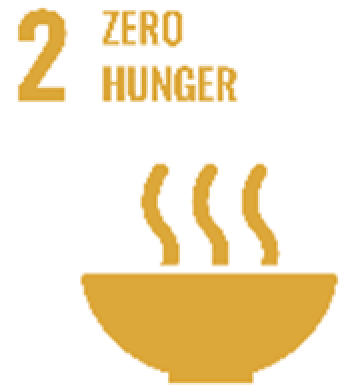 | 2.4 ensure sustainable food-production systems | ⬜ | 🔴 | 🟢 |
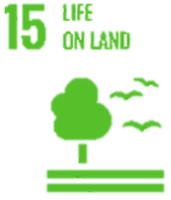 | 15.1 ensure the conservation, restoration, and sustainable use of terrestrial and inland freshwater ecosystems | 🟥 | 🔴 | 🟢 | |
| Applicable SDGs | Applicable Targets | Progress | Collagen | Chitin |
|---|---|---|---|---|
| Potential Contribution | ||||
 | 14.1 prevent and reduce marine pollution | 🟨 | 🟡 | 🟢 |
| 14.2 sustainably manage and protect marine and coastal ecosystems | 🟨 | 🟢 | 🟢 | |
| 14.a increase scientific knowledge, develop research capacity, and transfer marine technology for ocean health | 🟥 | 🟢 | 🟢 | |
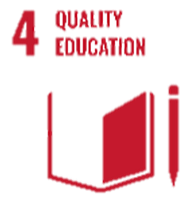 | 4.4 promotion of lifelong learning opportunities through capacity building, skills development | ⬜ | 🟡 | 🟡 |
| 4.7 acquire knowledge and skills to promote sustainable development | ⬜ | 🟡 | 🟡 | |
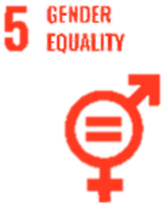 | 5.5 ensure women’s effective participation and equal opportunities for leadership | 🟥 | 🟡 | 🟡 |
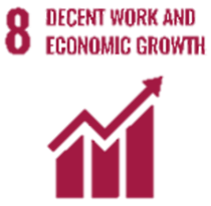 | 8.2 improve economic productivity through diversification and innovation | 🟥 | 🟡 | 🟡 |
| 8.3 promote policies for jobs, entrepreneurship, and innovation | 🟥 | 🟡 | 🟡 | |
| 8.4 improve resource efficiency in consumption and production | 🟨 | 🟡 | 🟡 | |
 | 9.5 enhance scientific research, upgrade the technological capabilities of industrial sectors | 🟩 | 🟡 | 🟡 |
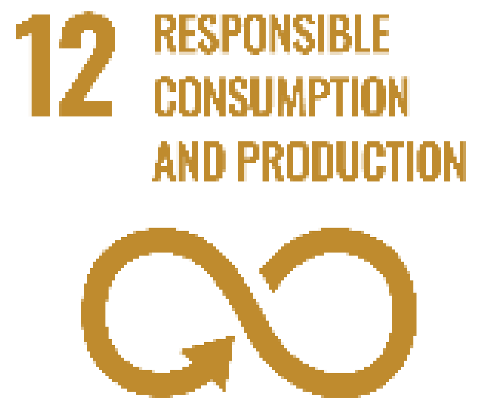 | 12.2 sustainable management and efficient use of natural resources | 🟥 | 🟢 | 🟢 |
| 12.3 food losses reduction along production and supply chains | 🟥 | 🟡 | 🟡 | |
| 12.5 reduce waste generation through prevention, reduction, recycling, and reuse | 🟥 | 🟢 | 🟢 | |
Disclaimer/Publisher’s Note: The statements, opinions and data contained in all publications are solely those of the individual author(s) and contributor(s) and not of MDPI and/or the editor(s). MDPI and/or the editor(s) disclaim responsibility for any injury to people or property resulting from any ideas, methods, instructions or products referred to in the content. |
© 2025 by the authors. Licensee MDPI, Basel, Switzerland. This article is an open access article distributed under the terms and conditions of the Creative Commons Attribution (CC BY) license (https://creativecommons.org/licenses/by/4.0/).
Share and Cite
Almeida, M.; Vieira, H. Marine-Derived Collagen and Chitosan: Perspectives on Applications Using the Lens of UN SDGs and Blue Bioeconomy Strategies. Mar. Drugs 2025, 23, 318. https://doi.org/10.3390/md23080318
Almeida M, Vieira H. Marine-Derived Collagen and Chitosan: Perspectives on Applications Using the Lens of UN SDGs and Blue Bioeconomy Strategies. Marine Drugs. 2025; 23(8):318. https://doi.org/10.3390/md23080318
Chicago/Turabian StyleAlmeida, Mariana, and Helena Vieira. 2025. "Marine-Derived Collagen and Chitosan: Perspectives on Applications Using the Lens of UN SDGs and Blue Bioeconomy Strategies" Marine Drugs 23, no. 8: 318. https://doi.org/10.3390/md23080318
APA StyleAlmeida, M., & Vieira, H. (2025). Marine-Derived Collagen and Chitosan: Perspectives on Applications Using the Lens of UN SDGs and Blue Bioeconomy Strategies. Marine Drugs, 23(8), 318. https://doi.org/10.3390/md23080318






